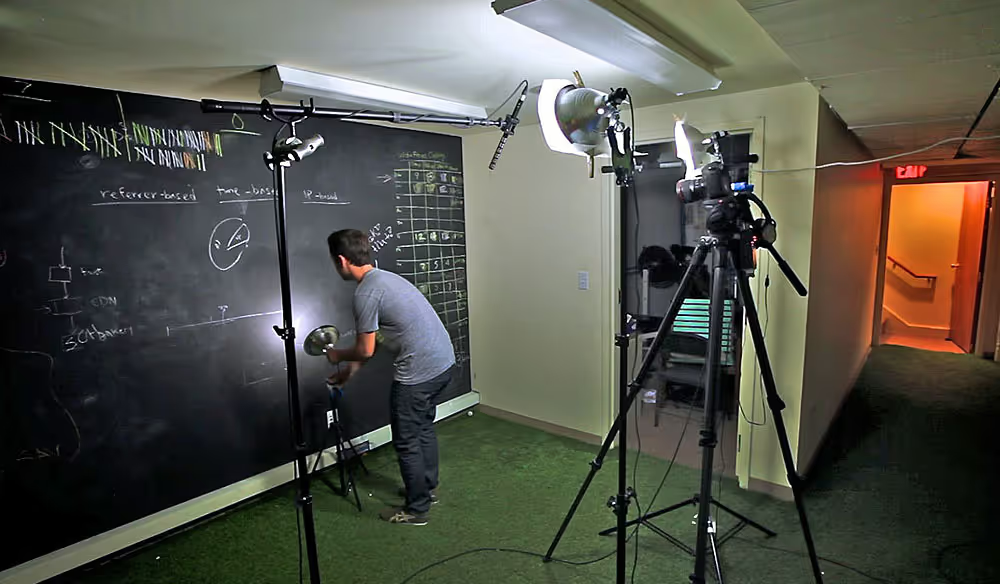Table of Contents
Your script is ready, you're satisfied with the final product, and you have some team members set for a shoot. But let's face it: even with a bit of money, you probably don't have enough to fully fund the project.
As a content creator, one thing I'm passionate about is shooting on a budget without compromising quality. If you want your film to be seen and your story to be told—why wouldn't you?—never compromise on quality. Instead of taking shortcuts, maximize your budget with the tips and tricks I've learned while making my own films.
What are filmmaking hacks?

Filmmaking hacks are creative techniques and strategies filmmakers use to overcome challenges like tight budgets, deadlines, and actor schedules. These tips and tricks help producers and film crews find alternative, cost-effective solutions to save time, streamline workflow, and achieve specific visual effects. However, these hacks aren't about cutting corners; they're more like time and budget savers.
Examples of filming hacks include repurposing household items as camera stabilizers, using keyboard shortcuts during editing, or creating DIY solutions for lighting effects. The poor man's process is a popular car cinematography hack; instead of shooting from a moving vehicle, crew members shake a stationary car while actors are inside. Filmmakers can also save on props and expensive set pieces by reusing furniture on different sets and buying affordable vintage clothing instead of new items. Another hack is using sunlight to manipulate shadows and create cinematic effects. In essence, filming hacks boost efficiency and nurture creativity. So if you're seeking inventive solutions to common filming challenges, here are 10 filmmaking hacks for 2024.
Filmmaking Hacks to Save Production Budget
Use Two Cameras
Filming with two cameras lets you capture different angles, giving your videos a more professional look. If you don't have advanced editing software, make sure to use the same type of camera for both angles to maintain consistent picture quality. Multiple angles and shots add depth to your videos, and you don't need expensive equipment. Many smartphones have high-quality cameras nowadays. Just place your phones on a stable surface and start filming! Phone mounts help keep your cameras steady.
Use a Storyboard or Script
For videos with a storyline, use a storyboard or script to visualize the shots and stay organized during filming. If it's a testimonial video, provide the focus with questions beforehand so they can prepare their responses. Prepared answers reduce the need for extensive editing and ensure you get the desired quality responses.
No Microphone? No Problem! Add Music to Your Videos
To mask poor audio quality, add music to your videos. Be cautious not to make the music too loud, as it can drown out the audio and lower video quality. If you lack a microphone, use your iPhone for a voice recording and add that audio later. While this requires more editing, it's worthwhile if your audio is subpar and adding music to conceal background noise isn't effective. Even with excellent audio, adding music is an easy way to enhance video quality. Platforms like YouTube, Soundcloud, and Facebook offer free audio libraries with a variety of songs and sound effects.
Be Creative when it comes to providing meals for your cast and crew
If you're working on a tight budget project, it's crucial to ensure your cast and crew are well-fed. Everyone is happier with a full belly—it's a kind of reward. Craft services and meals can be expensive, but did you know that many restaurants have a budget for monthly donations? Give local restaurants a call, explain your project, and make a pitch. They might say no, but you'd be surprised how often this has worked for me.
Don't cut corners on pre-production
Although this is a broader topic, the better your pre-production, the smoother your shooting schedule and the more money you can save. Efficiency happens when everyone is on the same page, so ensure your entire crew understands and shares the vision before the cameras start rolling.
Additionally, effective planning may enable you to reduce shoot days. For instance, if a scene involves multiple actors needed for another scene, shoot both on the same day. If possible, set up the next day's shoot before finishing the current day, allowing you to arrive ready to shoot and reducing setup time.
Opt for a flat rate.
We strongly believe in compensating your crew for their work, but one budget-stretching strategy is offering a flat rate instead of a day rate. When presenting your budget, offer what you have for the entire project rather than what you can afford on a day-to-day basis.
Involve your editor in the project before shooting
The more your editor is part of the project during filming, the more you'll save on editing. Bringing them in from the start helps piece things together before and during shooting, giving you a head start on post-production.
Barter
Utilize the creative skills you've acquired along the way to barter when possible. Offer to be a production assistant for someone's project if they assist with yours, or lend them your car for an errand. Get creative and don't hesitate to ask.
We live in a time where nearly anything is possible for us as creatives, and we no longer need to sit and wait for someone else. The ability to do it ourselves is a powerful position, so go ahead and make your project happen!
Keep things consistent in your video shooting spots and sound
When you're aiming for high-quality and professional videos, sticking to a consistent approach is crucial. If you're manually adjusting camera settings, ensure all clips are shot using the same or similar settings to maintain a consistent video quality. Stick to the same location unless a change is essential for the storyline. Unexpected shifts in location can confuse viewers and make your video appear messy. Also, changing locations may impact audio quality. If you don't have access to advanced audio editing tools or want to minimize editing work, film in a quiet place. Background noise distracts your audience and gives your video an unprofessional look. If you end up with some background noise, you can refer back to tip #3: add music to your videos.
Maximize the potential of the tools you have.
Don't attempt to do more than your equipment allows. If you don't have expensive, professional camera gear or editing software, don't push beyond your equipment's capabilities. This can compromise your video quality and consume more time and effort than necessary. Simple videos can be just as effective as elaborate ones, and there are many excellent apps and affordable tools available for you to use! Check out these helpful video editing tools: [Tool recommendations].
Try Our Services!
Need stunning visuals to take your project to the next level? Get Camera Crew has you covered! We connect you with a global network of talented videographers, camera crews, and even drone operators, ready to capture your vision no matter the budget. Whether you're dreaming of a cinematic masterpiece or a tight-but-mighty explainer video, we can work with you to craft a package that delivers professional results and seamless project management. Let's turn your vision into reality – contact Get Camera Crew today and tell us your budget, we'll tailor a video magic solution just for you!






